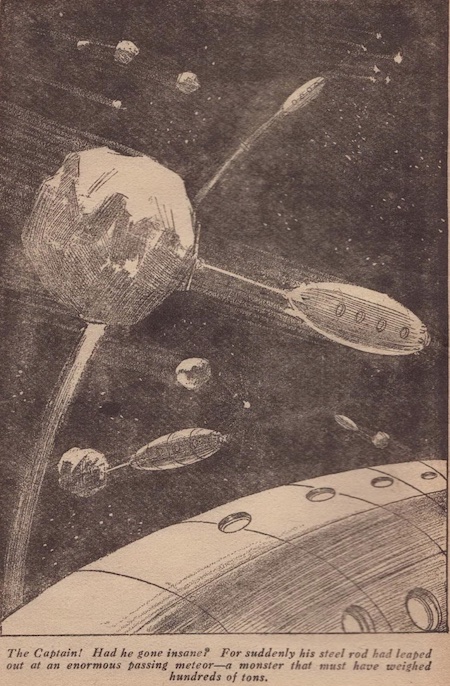Science Fiction
Dictionary
A B C D E F G H I J K L M N O P Q R S T U V W X Y Z
Latest By
Category:
Armor
Artificial
Intelligence
Biology
Clothing
Communication
Computers
Culture
Data Storage
Displays
Engineering
Entertainment
Food
Input Devices
Lifestyle
Living Space
Manufacturing
Material
Media
Medical
Miscellaneous
Robotics
Security
Space Tech
Spacecraft
Surveillance
Transportation
Travel
Vehicle
Virtual
Person
Warfare
Weapon
Work
"SF looks towards an imaginary future, while fantasy, by and large, looks towards an imaginary past."
- Frederik Pohl
| Meteor Swarm Mining | ||
| A fleet of ships hunting for meteoric iron - in space! |
| Steve Anders was a meteor miner, one of the first in space — and, in his prime, one of the best. The E. V. & M. was still a dream in the mind of a lad named H. C. MacDonald, as Steve shipped on his first dangerous cruise into the void. At that time, a group of venturesome young men came to the conclusion that there were vast possibilities in salvaging the countless tons of almost pure iron that were flashing through space as iron meteors**, and which could be had for the taking. They had organized The Meteoric Iron Co. Derisively they had been called “meteor miners” — and the name had stuck...
 ('The Meteor Miners' by L.A. Eshbach) It was October, and he was discussing wish his superior the forthcoming departure of the fleet for the Andromids*. the swarm of meteors which touched earth's orbit, between the seventeenth and twenty-seventh of the following month. The cruisers would follow the path of the swarm for three months, stowing meteoric iron into their holds. And return to earth with their haul, unload, outfit their crafts for another voyage— and head out into space in search of another meteoric swarm. ** Meteors are roughly divided Into two groups — stone and iron meteors. The iron meteors — or meteorites, as they are called after they fall to earth— are exhibited in museums, and are the more numerous to be found there, but this is because they are the more easily identified. The stone ones outnumber them by about twenty to one. Iron meteors are nearly pure iron with usually a small admixture of nickel. Stone meteors also contain grains of iron, as well as numerous other elements including gases — but these held no interest for the meteor miners. * A swarm of meteors moving around the Sun on an elliptic orbit, possessing a period of 6.6 years. According to popular astronmomical belief, the Andromids are the remnants of Biela's comet which In 1846 divided into two, and subsequently disintegrated, to form a swarm of Meteors. This particular swarm, like others that touch the orbit of the earth, was named for the constellation — Andromeda — from which It appears to radiate, ie. its radiant. |
| Technovelgy from The Meteor Miners,
by L.A. Eshbach. Published by Amazing Stories in 1935 Additional resources -
|
What a sight they were!
As far as I know, the first reference to asteroid mining Is from Edison's Conquest of Mars (1898) by Garrett P. Serviss.
In wedge formation the thirty-three cruisers of the Meteor Fleet flashed through space toward the Andromids. The space ship Atlas, with Captain Cal Barker in command, formed the apex of the wedge. They would maintain that formation until they reached the meteoric swarm, then they would separate and spread out over the Andromid’s orbit, to reunite three months later for the return to earth.
Comment/Join this discussion ( 0 ) | RSS/XML | Blog This |
Additional
resources:
More Ideas
and Technology from The Meteor Miners
More Ideas
and Technology by L.A. Eshbach
Tech news articles related to The Meteor Miners
Tech news articles related to works by L.A. Eshbach
| Will Space Stations Have Large Interior Spaces Again? |
| Reflect Orbital Offers 'Sunlight on Demand' And Light Pollution |
| Chrysalis Generation Ship to Alpha Centauri |
| The First Space Warship For Space Force |
Want to Contribute an
Item?
It's easy:
Get the name of the item, a
quote, the book's name and the author's name, and Add
it here.
| <Previous | Next> |
|
|
|
Technovelgy (that's tech-novel-gee!) is devoted to the creative science inventions and ideas of sf authors. Look for the Invention Category that interests you, the Glossary, the Science Fiction Invention Timeline, or see what's New.
|
Science Fiction
Timeline
1600-1899
1900-1939
1940's 1950's
1960's 1970's
1980's 1990's
2000's 2010's
'The observation vehicle was of that peculiar variety used in conveying a large number of people across rough terrain.'
'The real border was defended by... a swarm of quasi-independent aerostats.'
'I ... set my automatic astronomical instruments to searching for a habitable planet.'
'...haven't you a section of the factory where only robot labor is employed?'
'... oblongs were all over the floor and surfaces.'
